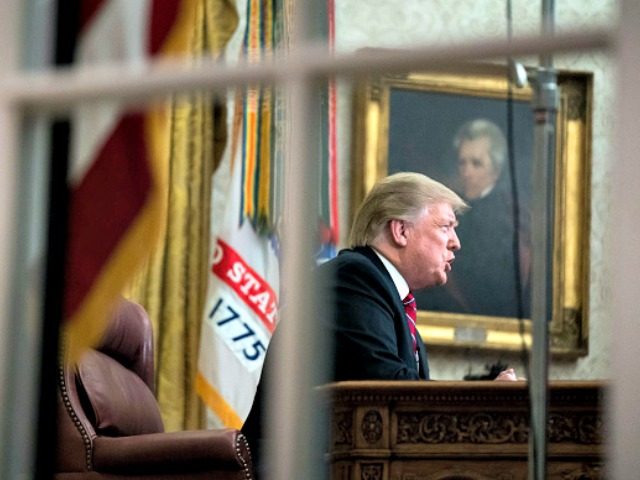President Trump’s address to the nation from the Oval Office on the border crisis Tuesday evening set the stage for the 2020 presidential campaign.
The president began his eight minute address by noting that “There is a growing security and humanitarian crisis at our southern border.”
It is, he added, “a crisis of the heart and a crisis of the soul.”
He then outlined the statistical evidence that proves the crisis and added to that the very personal details of individual Americans killed by illegal aliens in this country.
Speaker of the House Nancy Pelosi (D-CA) and Senate Minority Leader Chuck Schumer (D-NY), two of the least popular politicians in the country, sounded a very different tone in the Democratic response.
The president is trying to “manufacture a crisis, stoke fear, and divert attention from turmoil,” Schumer said.
The real issue should be ending the federal government shutdown, the Democratic leaders argued.
Both claimed Democrats also want border security, but methods other than a wall should be used to accomplish that.
“The fact is,” Pelosi asserted, “walls are an expensive and ineffective way” to address border security.
Trump made no mention that he is considering the possibility of declaring a national emergency in order to build the wall using Department of Defense funding, as many expected.
That option, however, looms over his invitation to Democrats to meet with him in the White House tomorrow.
As Breitbart’s Joel Pollak noted, the president talked victims, while Schumer and Pelosi talked government.
Going in to the president’s Oval Office address, more Americans agreed with the president than agreed with Schumer and Pelosi.
A poll released by Morning Consult and Politico earlier on Tuesday showed that a plurality of Americans support President Trump’s assertion that the country is facing a crisis at the border, as Breitbart News reported:
Forty-two percent of voters say the “U.S. is facing a crisis,” while only 37 percent say the “U.S. is facing a problem,” according to the poll of 1,989 registered voters, which was conducted with Politico.
Amid the flows of migrants and drugs from Central America, 12 percent say the U.S. “isn’t facing a problem or crisis,” according to the poll, which was conducted January 4 to 6.
Among Republicans, 72 percent believe the U.S. is facing a crisis, 19 percent believe it’s a problem, and four percent say there’s neither a problem nor a crisis.
Among Democrats, only 19 percent believe the U.S. is facing a crisis, 52 percent believe it’s a problem, and 21 percent say there’s neither a problem nor a crisis.
Among Independents, 37 percent believe the U.S. is facing a crisis, 37 percent believe it’s a problem, and ten percent say there’s neither a problem nor a crisis.
As the 2016 presidential results proved, however, aggregate voter behavior at the national level does not determine who is elected president by the electoral college.
Hillary Clinton won the popular vote by a 48 percent to 46 percent margin, but Donald Trump won the electoral college vote (excluding the seven faithless electors) by a 306 to 232 margin.
What matters in determining who will receive a majority of the electoral college votes necessary to win the 2020 presidential election is voter behavior at the state level, and specifically, voting behavior in 17 battleground states where the outcome of the 2020 presidential election is uncertain. (Those 17 states include Arizona, New Mexico, Colorado, Nevada, Minnesota, Iowa, Missouri, Wisconsin, Michigan, Ohio, Indiana, Pennsylvania, New Hampshire, Maine, North Carolina, Virginia, and Florida).
No matter who the Democratic nominee is, 13 blue states and the District of Columbia are certain to vote for the Democrat. (Those 13 states include Hawaii, Oregon, Washington, California, Illinois, New York, Maryland, Delaware, New Jersey, Connecticut, Massachusetts, Vermont, and Rhode Island.)
President Trump, the likely Republican nominee, is almost certain to win 20 red states (Alaska, Idaho, Montana, Utah, North Dakota, South Dakota, Nebraska, Kansas, Oklahoma, Texas, Kentucky, Louisiana, Arkansas, Tennessee, Mississippi, Alabama, Georgia, South Carolina, West Virginia, and Wyoming.)
The president and the Democratic leaders spelled out two vastly different views of what is important to the American people Tuesday evening.
Republicans almost universally rallied to the president’s call to action, while Democrats stood by Pelosi and Schumer.
Those competing views will set the stage for the next 22 months of political battle leading up to the November 2020 presidential election.
While the argument may well make the blue states bluer, and the red states redder, and perhaps even give the Democrat candidate a greater popular vote margin in 2020 than Hillary Clinton had in 2016, in the end, it will be how those arguments play out in the minds of voters in the 17 battleground states that will determine who secures the electoral college majority to win the presidency in 2020.

COMMENTS
Please let us know if you're having issues with commenting.